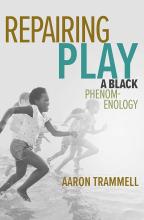
by Aaron Trammell
MIT PRESS, 2023, 144 PP.
PAPERBACK, $20.00
ISBN: 978-0-262-54527-3
Repairing Play: A Black Phenomenology is a valuable read. Author Aaron Trammell engages in a critical examination of the academic interpretation of play, widely examining global scholars from a North American lens that not only opens bodies of literature for postmortem examination but also does so meaningfully. Evidence of historical mis-interpretation of play abounds for reasons that are sometimes as much about the era from which they were conceived as from the logical or observational errors in prior academic work.
As one would expect of any approach to repair, Trammell begins with explaining what is wrong. Aptly, he identifies the specific problems as a product of colonial identification that conveniently frames play’s positives as a way of ignoring or obscuring other cultures. The cultural absence, while centered on the Black community, is extended to BIPOC communities globally. For Trammell, the path toward repair is one of both pain and pleasure, a path whose negative side doesn’t often find voice in academic literature on games and play.
The work does well to find intersections across media, from music to theater, to give evidence to the promise of this repair and carry the conceptual journey. The diagnosis is well-informed, and the solution reads as appropriate. Missing from a great deal of the accepted understanding of play, in Trammell’s terms, are reconciliations with what play is rather than what play aims to be. In the book’s terms, oft-cited works “speak more to a desire of what play should be rather than from an observation of what play is” (57). This is one of the most valuable thematic observations of the book. It echoes in observations about the paradox of civilized society doing uncivilized acts, in the way torture and consent are interpreted, in defining savagery, and in many other discomforting experiences that chip away at the idealization of play. Trammell points the reader’s gaze toward the problem and picks at its skin to show a kind of rot fed by colonial history.
The call to action is most emphasized in the fifth chapter, “Recentering Blackness in Games and Play.” It is not merely a call to decolonize, it is a call to repair and build. If the best understanding of play is a product of a balanced perspective, then Trammell is calling readers to add balance that emerges from play’s history and reality. This chorus of reconciliation between an idealized history and the pain of its past is like many calls for a more realistic understanding of society and culture. It reminds the reader to look beyond what play has been idealized to offer and acknowledge what it is. The book argues that in order to fill the holes that have formed in our construction of play, we must add back what has been historically left out.
Surprisingly, the book does little to discuss the ways that play is also work, despite clear emphasis on “the more insidious ways play has functioned as a tool of subjugation” (5). This is perhaps my one criticism of an otherwise complex examination. Labor, the work of play, the energy expended, the time spent, the investment in resources, and the value of such work toward all species, including humanity, seem absent. This is not merely a missed opportunity to look beyond the positives of play but instead a notably absent discussion, given the book’s repeated references to slave history and the ultimate reference to reparations.
Structurally, there is also an irony in the ways that this work must acknowledge and cite problematic prior work. In so doing, Trammell’s book pays a kind of tribute, in academic currency, to the historical past that it critiques. It is as though, instead of inventing a new path forward, the work must pay the debt of play’s past academic transgressions in order to be free from their bondage. Perhaps, however, this is because work from the perspective of slave history is distinct from a voluntary labor of love, or the work of learning something new through play.
In sum, the work points a lens at the center of academic analysis of play, then moves to its edges to show the logical and structural holes in the way play has been defined. In some ways, this maneuver is akin to moving the reader away from interpreting the world as flat and toward instead hinting that it may have more curve than previously thought. Such radical shifts typically prove to be an opportunity to improve everyone’s work. I suspect Trammell’s research will do the same, acknowledging historical absences, demonstrating how past work misshapes our understanding, and offering a way to correct that.
Repairing Play is certainly brave in its proclamations, offering the observation, for example, that “play reduces humans to objects because play is violent” (88). Yet if work is to take on the edifice of play’s academic history, it must be bold and sharp to pierce the well-fortified colossus on which much modern analysis is built. In this work’s brief pages, Trammell casts a stone that may resonate reflexively among the BIPOC community and perhaps beyond.
Trammell’s analysis is valuable because it reminds the reader to think more critically, to ask wider questions, and to create a dialogue about formal interpretations of play. These are the areas in which the book adds value. That it is the first to do so from a Black perspective only strengthens its value in academic milieux of game studies.
—Lindsay Grace, University of Miami

